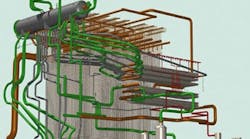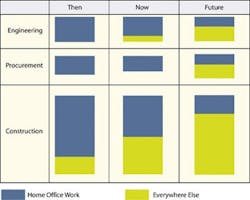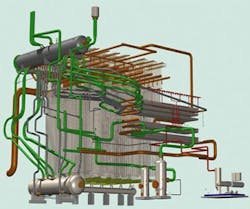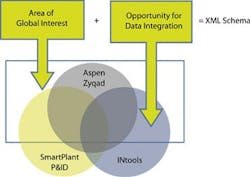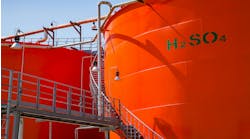The idea of one group of engineers working with another -- either within or outside an organization -- is hardly new. Companies in the chemical industry have long collaborated with academic researchers, joint venture partners, suppliers, subcontractors and other allies. In recent years, however, the pace of collaboration has seen a step-change increase.
Part of the reason for this is simple necessity. Companies have pared support staff to the bone to ride out the recent industry recession. More firms also are partnering to share the increasing costs -- and risks -- of many lines of business. Fluctuating energy costs, for example, make joining together with an energy provider particularly attractive for energy-intensive processes. Another reason is business managers' belief that they can reduce support costs by contracting the work to outside organizations, otherwise known as "outsourcing."
On the engineering technology side, a similar step change is occurring. For years, technologists have bemoaned the overspecialization of engineering disciplines and the need for team efforts to handle production problems. Meanwhile, engineering software applications, originally built to address specific design or operational problems, have become multi-featured. Moreover, the need for passing data from, say, a process control system to a planning and scheduling program has grown. The step change occurring in engineering technology is being driven by the latest capabilities of design and operating software to exchange these data.
"There's no question that collaboration is one of the top 10 issues in engineering software," says Monica Schnitger, senior vice president for market-research firm Daratech, Cambridge, Mass. "At the same time, most observers agree that the technology is mostly there, but the work processes in engineering organizations are lacking."
At Daratech's Plant2004 conference, which was held in Houston in late January, keynote speaker K. C. Choi, chief information officer for the petroleum and chemical division of Bechtel, San Francisco, stressed the increasingly diverse environment in which the contractor operates. The Nanhai, China, petrochemical project, where engineering design is complete and construction has begun, is a good example. The massive, $4.4 billion project involves two joint venture partners, China National Offshore Oil Co. and Shell Petrochemicals Co.; three prime contractors: Bechtel, Foster Wheeler Ltd. and Sinopec Engineering Inc.; and numerous subcontractors throughout the world.
As Choi sees it, less and less engineering work will be conducted from the home offices of engineering and construction companies (E&Cs). "Successful information-sharing is the key to making these projects work," he says. Bert Aragon, a vice president for Kellogg Brown & Root, Houston, who was also a presenter at the conference, agrees. He notes that there is a trend toward performing more engineering work at local or regional offices and less at the home offices of the E&Cs (Figure 1), which necessitates active collaboration.
Figure 1.
Data-centric design
Along the way, improved data transmission technology and the Internet enabled design firms to distribute design work among multiple offices or between contractors who are sharing the overall design-construction process. This now is a fairly routine process. "With the right procedural controls in place, and sufficient data-trunkline capacity, it is straightforward to run a project from multiple locations," Bechtel's Choi says. A global organization like Bechtel can work on a project around the clock, "following the sun," as the expression goes, with an office in the United States handing off a project to an office in Asia at the end of the American day. Then the Asian operation, in turn, forwards it to a European office.
Figure 2.
Two types of files are critical in this process: a 2D or 3D drawing or model, as well as a piping and instrumentation diagram (P&ID). In both cases, information technology (IT) vendors and their engineering customers have been pushing for more "intelligence" in the files, so they go beyond a static illustration to provide an accessible list of specifications and dimensions ," and even vendor information, in the case of a purchased piece of equipment. This intelligence enhances the design and procurement process, and -- most importantly -- then provides a valuable database for the plant owner. That database, for instance, can serve as part of an asset-management system for production, maintenance and monitoring of the plant.
Adding this intelligence, however, is not a trivial task. During the past several years, software vendors have shifted to a "data-centric" data-management approach from a "document-centric" method. This allows equipment specifications to be stored in a form that is readily transferable from engineering contractor to plant owner. A more subtle but more profound result is the ability to decompose a model or P&ID to its components while the design process is going on -- the better to speed collaborative efforts. "True collaboration can be understood as the ability to work on the same design element from two different locations, at more or less the same time," says Keith Denton, a business development manager at engineering-IT vendor Intergraph, Huntsville, Ala. "With a 3D model, you're often dealing with huge databases that require very careful version control, so that each member of a team is working on the same version of the design." With the shift to data-centric design, each P&ID or equipment drawing is simply a group of queries of the database, which can be handled relatively quickly. When set up correctly, version control becomes an embedded feature of the system.
To make such a system perform at its optimum, Denton says, a large project requires not one central database, but a group of them (for example, one at each engineering office that is working on a project). The databases run their own transaction updating. "We're borrowing technology that was developed during the Internet boom to support e-commerce on the Web," he says. "This is a built-in feature of most commercially available database systems."
Intergraph announced its Engineering Foundation brand for data management several years ago and has been gradually rolling out CAD tools that are compatible with the new structure. Not surprisingly, other CAD vendors are taking the same approach. For instance, Aveva, Cambridge, England, offers the Aveva Vantage system; Bentley Systems, Exton, Pa., provides its ProjectWise system; and CEA Technology, Rotterdam, Netherlands, has its Plant4D system.
The latest development in this area was the acquisition in January of ESSI, Huntsville, Ala., by Bentley. ESSI had been set up as a joint venture between Bechtel and Fluor Corp. Its main product is EWarehouse, a data storage system intended to maintain plant data from conception through the life of the plant. "Integrating design and data warehousing means that data warehousing becomes more cost-effective and broadly used, and the benefits to users -- including EPCs [engineer/procure/construct firms] and owner-operators -- increased proportionately," says Greg Bentley, CEO of the same-named company.
The changing work process
Collaboration is only one of the buzzwords driving this evolution: another is "global worksharing." In either case, the approach is to create a pool of shared expertise and then to assemble the best team, regardless of the location of the specific individuals, to handle project work.
Fluor Corp., Alijo Viejo, Calif., has won industry plaudits for its global worksharing organization. The company has set up a Project Execution Services Group, which manages the overall allocation of resources to projects, notes Peter Moore, general manager, engineering, at Fluor's Houston office. Under that exists a Project Excellence Network, which organizes the functional areas of expertise within the company. A parallel structure is the network of "knowledge communities," which are Internet-based forums in which company experts of various kinds, no matter where they are based, can interact.
"The operative idea here is to leverage our resources," Moore says. Teams assembled for a project from the Excellence Network can focus on a particular project, but remain in touch with each other through the knowledge community. Communities have forum leaders, and their responsibility is to ensure that questions posted within the community receive responses within 24 hours.
Fluor has been rated No. 1 in the engineering construction category of Fortune magazine's "Most Admired Companies." Fluor's managers point to its networked structure as a key factor. "We're no longer just a group of people assigned to various projects," says John McQuary, manager of technology strategy at the firm. "We bring our intellectual capital from across the world to resolve issues in a timely fashion, and to bring the collective wisdom of the company to the table. Our clients will continue to drive us to deliver better, faster and cheaper."
Cross-company borders
These system incompatibilities raise the perennial IT issue of "closed" versus "open" systems and the call for industry-wide standards on data transfer. IT vendors grudgingly have accepted standardization efforts, but also have leapfrogged these efforts by commercializing advances in technology. This seems to be happening right now with regard to standardized file formats. If equipment data are being decomposed to smaller elements, it makes little sense to develop a standard file format.
Intergraph's Denton cites one standardization effort that has moved quickly enough to have an impact on industry practices: the CIMsteel standard for structural steel. "With this standard, we're able to produce a design that can be smoothly transferred to a client for their review, and then to a fabricator for actual construction," he says. The standard is being built into Intergraph's SmartPlant products. Denton concedes that comparable efforts involving electrical or mechanical components of plant designs are "light years" behind the CIMsteel standard.
Bechtel's Choi points to evolving XML standards coming out of the Internet community of software developers. XML provides a broader and more up-to-date method of exchanging data over the Internet, and some programs are already designed to make use of it. XML is a fundamental level of software language rules; vendors in specific markets such as engineering-construction will have to adapt it to their uses (Figure 3).
Figure 3.
Collaboration can go on, of course, outside the realm of data and computer programs. UOP LLC, Des Plaines, Ill., is involved both with IT-related collaborations as well as staffing and work-process collaborations with its clients. In recent months, the company announced alliances with Honeywell Industrial Automation and Control, Phoenix, Ariz., to integrate performance-improvement services with the delivery of control or performance management IT systems. "This will enable our clients to synchronize the delivery of technology systems and refining expertise, thereby allowing them to achieve the elusive 'full value' of their technology investments," says Pedro Fernandez, sales and marketing director, UOP Solutions and Services.
UOP also has a longstanding consulting practice with its clients. The company says that a "truly collaborative" relationship exists between BP and UOP. Under it, UOP provides support, delivery and implementation of technology and services to BP refineries around the world, ranging from process operations to capital planning or technology development. "A very important aspect of this collaboration is that UOP's compensation is tied to BP's success," Fernandez says.
However, collaboration certainly can fail to meet its potential. At the Plant2004 meeting, Jack DeBrunner, manager of capital projects at Procter & Gamble, Cincinnati, cautioned that IT systems set up for broad-based collaboration can stumble when dealing with real-world production environments. He described a recent effort to implement a company-wide document-management system, which would standardize how important records were stored and updated for its global base of plants. "What we overlooked was that many of our plants had developed shortcut approaches to this task that worked well for them, but differed from location to location," he says. However, the efficiency expected in the enterprise-wide system only occurs with a standardized approach. "The key will be to have such information systems equipped with a user interface that can be customized to local 'flavors,' while still having the necessary underlying structure," he says.
Nick Basta is editor at large for Chemical Processing magazine. E-mail him at [email protected].
